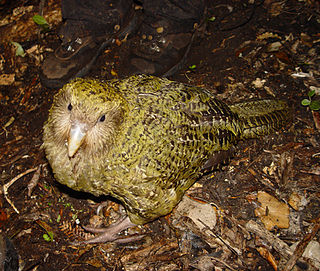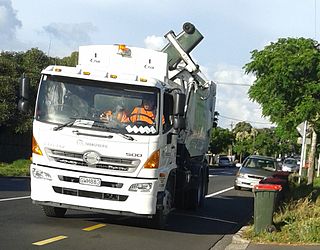This is a timeline of environmental history of New Zealand. It includes notable events affecting the natural environment of New Zealand as a result of human activity.

The Resource Management Act (RMA) passed in 1991 in New Zealand is a significant, and at times, controversial Act of Parliament. The RMA promotes the sustainable management of natural and physical resources such as land, air and water. New Zealand's Ministry for the Environment describes the RMA as New Zealand's principal legislation for environmental management.
The Ministry for the Environment is the public service department of New Zealand charged with advising the New Zealand Government on policies and issues affecting the environment, in addition to the relevant environmental laws and standards. The Environment Act 1986 is the statute that establishes the Ministry.
Environmental law in New Zealand is an increasingly well defined body of national law that has a specialist court, The Environment Court of New Zealand, to decide related issues.

The Environment Court of New Zealand is a specialist court for plans, resource consents and environmental issues. It mainly deals with issues arising under the Resource Management Act, meaning that it covers a wide range of potential future effects of planning applications, which can include such areas as traffic congestion, noise/pollution emissions and social and commercial consequences, rather than just the 'ecological' aspects that could be implied by the 'environmental' term.

The birds of New Zealand evolved into an avifauna that included many endemic species found in no other country. As an island archipelago, New Zealand accumulated bird diversity, and when Captain James Cook arrived in the 1770s he noted that the bird song was deafening.

Despite abundant natural resources and a relatively small population, New Zealand is a net importer of energy, in the form of petroleum products. The ratio of non-renewable and renewable energy sources was fairly consistent from 1975 to 2008, with about 70 per cent of primary energy supply coming from hydrocarbon fuels. This ratio decreased to about 60 per cent in 2018. The proportion of non-renewable energy varies annually, depending on water flows into hydro-electricity lakes and demand for energy. In 2018, approximately 60% of primary energy was from non-renewable hydrocarbon fuels and 40% was from renewable sources. In 2007 energy consumption per capita was 120 gigajoules. Per capita energy consumption had increased 8 per cent since 1998. New Zealand uses more energy per capita than 17 of 30 OECD countries. New Zealand is one of 13 OECD countries that does not operate nuclear power stations.

New Zealand–United Kingdom relations are the bilateral relations between New Zealand and the United Kingdom. New Zealand has maintained a close relationship with Britain, since gaining independence from the United Kingdom.

The environment of New Zealand is characterised by an endemic flora and fauna which has evolved in near isolation from the rest of the world. The main islands of New Zealand span two biomes, temperate and subtropical, complicated by large mountainous areas above the tree line. There are also numerous smaller islands which extend into the subantarctic. The prevailing weather systems bring significantly more rain to the west of the country. New Zealand's territorial waters cover a much larger area than its landmass and extend over the continental shelf and abyssal plateau in the South Pacific Ocean, Tasman Sea and Southern ocean.

The use of tobacco for smoking in New Zealand has been subjected to government regulation for a number of decades. On 10 December 2004, New Zealand became the third country in the world to make all indoor workplaces including bars and restaurants smoke-free. The smoking rate in New Zealand was about 8% as of 2023 when the new government planned to eliminate the nation's smoking ban to fund tax cuts.

As with other countries, New Zealand's 200 nautical miles exclusive economic zone gives its fishing industry special fishing rights. It covers 4.1 million square kilometres. This is the sixth largest zone in the world, and is fourteen times the land area of New Zealand.

Biosecurity Act 1993 is an Act of Parliament in New Zealand. The Act is a restatement and reform of the laws relating to pests and other unwanted organisms. It was a world first.
An urban planner is a professional who practices in the field of town planning, urban planning or city planning.

The management of waste in New Zealand has become more regulated to reduce associated environmental issues. According to OECD data, New Zealand is the third most wasteful country in the OECD.

The Clean Air Act1972 was an Act of Parliament passed in New Zealand in 1972. It aimed to regulate industrial pollution by establishing a licensing system for permissible emission levels. This legislation also enhanced the monitoring of air quality in major urban centers and allowed for the creation of clean air zones by local authorities, as was done in Christchurch. The Act represented an early effort to reduce pollution from both residential and industrial sources. It was repealed by the Resource Management Act 1991.

The Fisheries Act 1983 is an Act of Parliament in New Zealand. An important provision of the Act was establishing the Quota Management System, one of the first individual fishing quota systems. The Act was largely repealed with the passage of the Fisheries Act 1996.

The Government Communications Security Bureau Act 2003 is a repealed New Zealand Act of Parliament. It formalised the role of the Government Communications Security Bureau, which had previously existed in various states of secrecy since 1977, as the national authority for signals intelligence and information systems security, and put it on a similar legislative footing to the New Zealand Security Intelligence Service.

The Natural and Built Environment Act 2023 (NBA), now repealed, was one of the three laws which will replace New Zealand's Resource Management Act 1991 (RMA). The NBA aimed to promote the protection and enhancement of the natural and built environment, while providing for housing and preparing for the effects of climate change.

The Smokefree Environments and Regulated Products Amendment Act 2022 is an act of the New Zealand Parliament that seeks to combat smoking by limiting the number of retailers allowed to sell smoked tobacco products; ban the sale of smoked tobacco products to anyone born on or after 1 January 2009; and to discourage the consumption of smoked tobacco products. The bill passed its third reading on 13 December 2022 and received royal assent on 16 December 2022. The new National-led coalition government announced in late November 2023 that they intended to repeal the legislation. The Smokefree legislation was repealed under urgency on 28 February 2024.

The Spatial Planning Act 2023 (SPA), now repealed, was one of three laws introduced by the Sixth Labour Government in order to replace New Zealand's Resource Management Act 1991 (RMA). Its purpose was to provide for regional spatial strategies that assisted the purpose of the Natural and Built Environment Act 2023 (NBA) and promote integration in the performance of functions under the NBA, the Land Transport Management Act 2003, the Local Government Act 2002, and the Water Services Entities Act 2022.









